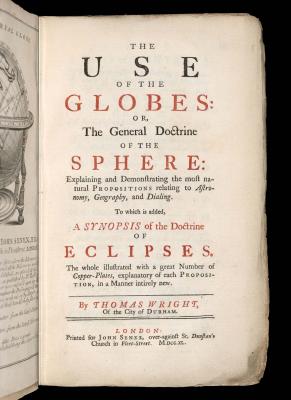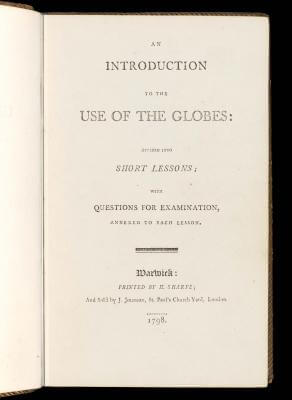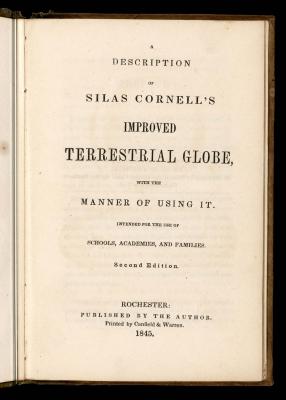EXHIBIT NAVIGATION
The globe manuals explain how to use celestial and terrestrial globes to solve a wide variety of mathematical and astronomical problems, from determining the difference in time between two places to determining the “climate” (latitudinal zone) and character of distant places. These manuals beginning with the earliest and moving well into the 19th century deal primarily with a set of cosmographical problems and are beholden to the works of Ptolemy, Copernicus, Schöner, and Gemma Frisius. From the earliest manual in OML’s collection, Jean Boulenger’s Traicte d las Sphere du Monde, through several 18th century works including Blaeu’s ‘t Werkstellige der Sterre-Konst and Wright’s The Use of Globes to 20th century works such as the 1847 Lessons on the globes they all feature the same core lessons and exercises. These deal with astronomical, geographical, navigational, astrological, gnomonical and trigonometrical problems to be solved using a usually a pair of globes. A brief survey of the manual’s produces some interesting insights including the use of globes in the open air to show the effect of the suns shadow on various parts of the earth as well as the use of globes with maps to solve complex computation problems. One example of this in John Gregory’s 1671 The description and use of globes specifically tells the user to refer to the “planispherical map of Hondius” from 1627, a double hemisphere map of which only two sheets survive in the Staatsarchiv at Nuremberg. (Shirley, 342)
The digitization of these manuals is integral to OML’s entire globe digitization project, as it puts the globes in context to their original creation and scholarly use. Many of the manuals were produced by globe makers to be used with specific globes, while other were produced to help instruction in cosmographical and geographical education. Interestingly enough Lessons on the Use of Globes from 1847 begins “Our Public Schools have, at least many of them, been provided with Globes, which have hitherto been comparatively useless, for the want of a suitable manual…” this manual points out an interesting contradiction: while lamenting the lack of a suitable manual, the author of Lessons then provides the same cosmographical exercises related to the Doctrine of the Sphere that go back centuries. Through the digitization and posting of the globe manuals on OML’s website, as well as the University of Southern Maine’s Digital Commons, site which supports optical character recognition and is crawled by Google, OML will make these resources available for researchers and the public world wide.
Traicte de la Sphere du Monde Divise en Quatre Livres, Ausquels Est Adiouste le Cinquiesme de l’usage d’icelle

Jean Boulenger, Paris, 1620
A Tutor to Astronomie and Geographie, or An Easie and Speedy way to Know the Use of Both the Globes, Coelestial and Terrestrial

Joseph Moxon, London, 1755
“The ancient stories of the several stars and constellations shewing the poetical reasons why such various figures are placed in heaven, collected from Dr. Hood.” 2nd edition, corrected and enlarged.
The Description and Use of the Terrestrial Globe.

John Gregory, London, 1671
Tract extracted from the author’s: “Gregorii Posthuma. London : Printed by A. Clark for T. Williams, 1671”
L’usage des Globes Celestes et Terrestres, et des Spheres, suivant les differents systemes du monde précedé‚ d’un traité‚ de cosmographie. Recüeillis par le sieur Bion, ingenieur pour les instrumens de Mathematiques. Nouvelle edition, corrigée, & enr

Nicolas Bion, Amsterdam, 1700
Einleitung zur Erkenntnis und Gebrauch der Erd- und Himmels-Kugel auf das deutlichste und leichteste in Frag und Antwort … eingerichtet ausgefertigt und mit nöthigen Figuren erlaütert von M. Johann Ludwig Hocker

Johann Ludwig Hocker, Nuremburg, 1734
The Use of the Globes: or, the general doctrine of the sphere: Explaining and demonstrating the most natural propositions relating to astronomy, geography, and dialing. To which is added, a synopsis of the doctrine of the eclipses. The whole illustrated

John Senex, London, 1740
Advertisements on 8 preliminary pages, p. 102, p.164, include globes, maps, and books sold at the Senex shop and a synopsis of the doctrine of eclipses.
A New and Easy Guide to the use of the Globes and Rudiments of Geography

Daniel Fenning, Dublin, 1769
The Description and Use of the Globes, and the Orrery : to which is prefix’d by way of introduction, a brief account of the solar system by Joseph Harris

Joseph Harris, London, 1783
Atlas des enfans ou nouvelle méthode pour apprendre la géographie : avec un nouveau traité de la sphere.

Jean Marie Bruyset, Lyon, 1790
Includes: Nouveau trait‚ de la sphere (p. 227-270) with special title page.
An introduction to the use of the globes divided into short lessons with questions for examination annexed to each lesson

William Field, Warwick, 1798
An essay, on the use of the celestial and terrestrial globes : exemplified in greater variety of problems, than are to be found in any other work exhibiting the general principles of dialing & navigation

George Adams, Philadelphia, 1800
A description of Silas Cornell’s improved terrestrial globe with the manner of using it

Silas Cornell, Rochester, 1845
Lessons on the Globes for the use of pupils in geography and astronomy compiled from the best authors simplified, abridged, modernized, Americanized, and adapted to the wants of public schools by a teacher

Oliver G. Steele, Buffalo, 1847
A description of Silas Cornell’s improved terrestrial globe with the manner of using it : intended for the use of schools, academies and families

Silas Cornell, Rochester, 1848
Lessons in Geography and Astronomy on the globes: supplementary to the text-books generally used on these subjects.

A. Fleming, Boston, 1866
Johann Schöner Professor of Mathematics at Nuremberg, A Reproduction of his Globe of 1523, long lost : his dedicatory letter to Reymer von Streytperck, and the “De Molvccis” of Maximilianus Transylvanus : with new translations and notes on the globe by He

Johann Schoner, Charles Coote, London, 1523/1888
Geographical questions, containing, a copious and minute reference to the different parts of the globe: with a table of all the most considerable towns, rivers, mountains, capes, and islands. A table of latitudes and longitudes, and a comparative view of ancient and modern geography.

John Griscom, New York, 1822
